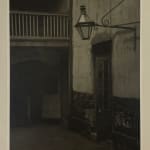Arnold Genthe
Collection of photographs from New Orleans, c. 1925
Toned silver prints (13)
Images 8 x 6 3/4 to 13 x 10 inches
Mounts 18 x 14 inches
Mounts 18 x 14 inches
Further images
-
(View a larger image of thumbnail 1
)

-
(View a larger image of thumbnail 2
)

-
(View a larger image of thumbnail 3
)

-
(View a larger image of thumbnail 4
)

-
(View a larger image of thumbnail 5
)

-
(View a larger image of thumbnail 6
)

-
(View a larger image of thumbnail 7
)

-
(View a larger image of thumbnail 8
)

-
(View a larger image of thumbnail 9
)

-
(View a larger image of thumbnail 10
)

-
(View a larger image of thumbnail 11
)

-
(View a larger image of thumbnail 12
)

-
(View a larger image of thumbnail 13
)

Arnold Genthe was a German American photographer of the pictorialism movement of the early 20th century. Although better known for his documentation of the San Francisco Chinatown before and after...
Arnold Genthe was a German American photographer of the pictorialism movement of the early 20th century. Although better known for his documentation of the San Francisco Chinatown before and after the great earthquake of 1906, Genthe produced considerable work of New Orleans during the 1920s. His pictorialist views of the city opposed the new banality of accessible and purely representational photography (afforded by the new Kodak camera). Set on capturing the Old World remnants of a rapidly modernizing city, Genthe edited out any neoteric signifiers such as electric lines. He reversed time in his photographs, successfully encapsulating an idyllic vision of the famous French Quarter and Garden District. This collection of vintage prints includes a number of images which were published in “Impressions of Old New Orleans” in 1926.
Genthe was born in Berlin during the Kingdom of Prussia on January 8, 1869. He received a philology doctorate from the University of Jena and studied at the Sorbonne. He immigrated to San Francisco to become the private tutor of the son of Baron J. Heinrich von Schroeder. There he learned photography and began taking images in Chinatown, often hiding the camera from the subjects. These images gained popularity and were included in local publications. His career took off and he opened a portrait studio that became frequented by celebrities, politicians, and other influential people. His studio was destroyed in the 1906 San Francisco earthquake but the images that survived were published in “Pictures of Old Chinatown” in 1909. He briefly lived at the artist colony Carmel-by-the-Sea before finding a more permanent residence in New York City in 1911. There he shot the likes of Theodore Roosevelt, Woodrow Wilson, John D. Rockefeller, Greta Garbo, and Isadora Duncan before he died on August 9, 1942. He was a highly influential photographer and much of his work is archived at the Library of Congress.
Genthe was born in Berlin during the Kingdom of Prussia on January 8, 1869. He received a philology doctorate from the University of Jena and studied at the Sorbonne. He immigrated to San Francisco to become the private tutor of the son of Baron J. Heinrich von Schroeder. There he learned photography and began taking images in Chinatown, often hiding the camera from the subjects. These images gained popularity and were included in local publications. His career took off and he opened a portrait studio that became frequented by celebrities, politicians, and other influential people. His studio was destroyed in the 1906 San Francisco earthquake but the images that survived were published in “Pictures of Old Chinatown” in 1909. He briefly lived at the artist colony Carmel-by-the-Sea before finding a more permanent residence in New York City in 1911. There he shot the likes of Theodore Roosevelt, Woodrow Wilson, John D. Rockefeller, Greta Garbo, and Isadora Duncan before he died on August 9, 1942. He was a highly influential photographer and much of his work is archived at the Library of Congress.












